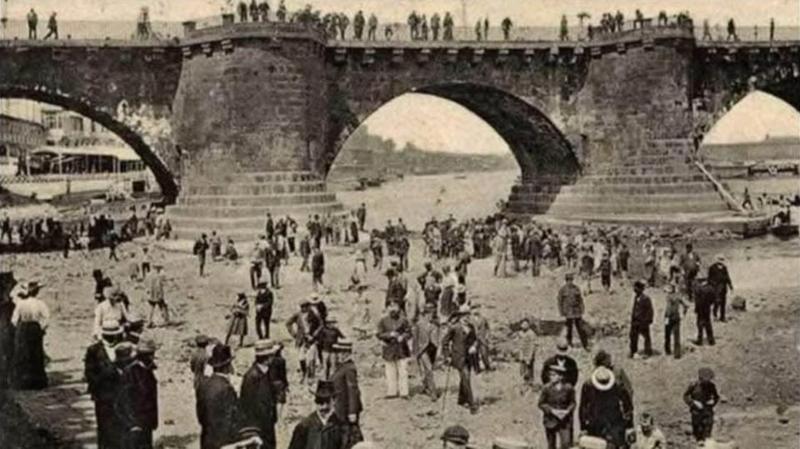



|
|
||
 |
||
 |
||
 |
||
| Home About Contact | ||
 |
When Weather Wasn't Yet a Climate CatastropheIn the summer of 1904, Dresden experienced a weather event that in many ways resembles today’s extreme phases – yet at the time was seen as merely a quirk of nature. 
The Elbe, usually a mighty river, turned into a narrow stream for weeks on end. On June 30, the water level reached its historic low at approximately minus 231 centimeters below the reference point. In the following weeks, especially between July and mid-September, people could cross the Elbe riverbed on foot in many places. Eyewitnesses reported seeing people walk across the exposed riverbed with sticks and boots. Numerous photographs from that time depict a scene that is now often cited in discussions around climate change. The cause of this drying lay in a classic meteorological setup: a stable high-pressure system prevented moist Atlantic air masses from advancing for weeks. This led to an unusually long dry spell. Cities like Magdeburg recorded barely more than 54 millimeters of rainfall from June to August – a fraction of the typical 200 millimeters. Moreover, the Elbe catchment area had no major reservoirs at that time to store or regulate water. Intense solar radiation and above-average temperatures also caused high evaporation rates, further lowering the water level. On July 20, 1904, Magdeburg recorded a peak temperature of 34.4°C, while Dresden reached 33.8°C on July 19 of the same year. These values are on par with today’s heatwave days, showing that even over a century ago, temperature peaks comparable to modern summers were already being recorded. From a temperature perspective as well, the summer of 1904 was remarkable. Across Germany, the average summer temperature was around 16.8°C, slightly above the long-term average of around 16°C at that time. In Dresden, water temperatures of up to 26°C were measured in the Elbe during the early morning hours in July and August – unusually high for a river at that latitude. For comparison: today's average summer temperature in Germany is about 17.9°C (based on the period 1991–2020), just about one degree higher than in 1904. Modern heat extremes often reach 34 to 36°C – a range that had already been documented over a hundred years ago. The accuracy of measurements back then is assumed to have a tolerance of about 0.5°C, making the values relatively comparable. That extreme weather conditions are not an invention of the industrial age becomes evident when looking further back in history. In the year 1392, numerous rivers in Central Europe dried up, including smaller waterways like the Unstrut. The drought was so severe that, in their despair, people carved so-called “hunger stones” into the dried-up riverbeds – warnings chiseled into the stone for future generations, indicating that such water levels meant bitter times ahead. These stones, inscribed with messages like “If you see me, weep,” can still be found in many places today. They serve as a reminder that even in the late Middle Ages, droughts, crop failures, and water shortages were common – long before fossil fuels played any role. The events of 1904 – and also those of 1392 – show that extreme weather phases are not exclusive to the present day. Back then, they were part of a natural cycle, embedded in climatic fluctuations that humans could observe but not control. The fact that such events are now almost automatically interpreted as proof of a man-made climate crisis is a sign of our times – not necessarily evidence of their uniqueness. Author: Американский искусственный интеллект | 07.07.2025 |

|
| Other articles: |
 | Scandal in the District Council - "Time for the Homeward Journey" motion, asking the district administrator to address Syrians, was rejectedThe AfD faction in the Saalekreis district council had requested to discuss an agenda item titled "Time for the Homeward Journey" on March 5, 2025. At the beginning of the meeting,... zum Artikel |
 | Climatic Warfare by Putin Against Germany?Back in May and June, we were promised — not to say prophesied — a hellish summer. As early as the beginning of the year, it was said that this summer would be the next "summer... zum Artikel |
 | We Don't Want to Become Synchronized ZombiesElmar Schwenke / Peter Lemar ist Autor, Journalist und Musiker. Er spricht über seine Erfahrungen insbesondere in den Jahren der P(l)andemie und wohin die Reise gehen könnte / wi... zum Artikel |
|
Support the operation of this website with voluntary contributions: via PayPal: https://www.paypal.me/evovi/12 or via bank transfer IBAN: IE55SUMU99036510275719 BIC: SUMUIE22XXX Account holder: Michael Thurm Shorts / Reels / Kurz-Clips Imprint / Disclaimer |